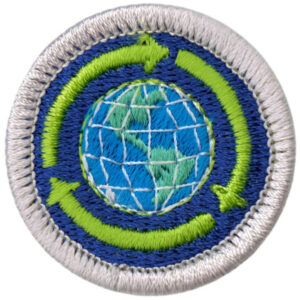The Sustainability merit badge challenges Scouts to think long-term—about the environment, society, and how their daily choices affect future generations. It’s a newer Eagle-required merit badge that encourages critical thinking about water, food, energy, waste, and how communities can thrive without depleting Earth’s resources.
This badge is especially important in today’s world. You’ll examine your personal and family habits, consider global sustainability issues, and learn ways to conserve resources and reduce your environmental footprint. If you’re curious about how to build a better future, this merit badge is the perfect place to start.
Timeframe / Difficulty
The Sustainability merit badge is moderately difficult and will likely take 2–4 weeks to complete depending on how you approach the tracking, planning, and observation requirements. Some components, such as tracking household habits or observing a campout, may take longer.
It’s best to work on this badge at home, with the involvement of your family, and then review your findings with your counselor. Many requirements involve real-life application, which makes it a valuable learning experience.
Tips for Success
1. Get your family involved.
You’ll need to track things like energy use, water habits, and food waste. Let your family know you’re working on this badge and ask for their support.
2. Use visuals where possible.
Sketches, charts, and diagrams help you understand complex systems—like energy production or water treatment—and make your reports more impressive.
3. Be honest and reflective.
You don’t need to be perfectly sustainable. The point is to learn and improve. Thoughtful reflection shows your commitment to the Scout Law and to real growth.
Complete Guide to the Sustainability Merit Badge
This guide is only intended as a starting point for your research. Directly copying the information offered here is plagiarism. Doing your own research will allow you to get the most out of this badge and maintain the 12 points of the scout law. A scout is trustworthy!
Here’s every requirement for the Sustainability merit badge, with guidance and tips for each part.
Requirement 1
1. Describe the meaning of sustainability in your own words. Explain the importance of sustainability to society and how you can contribute to fulfilling the needs of current generations without compromising the needs of future generations.
Tips:
- Sustainability means using resources wisely so that future generations still have access to clean air, water, and a healthy environment.
- Consider including examples like reducing plastic waste, saving water, or using renewable energy.
Requirement 2: Water
Do ONE of the following and discuss with your counselor:
(a) Evaluate your household water usage. If available, review water bills from the past year and evaluate the seasonal changes in water use. Identify three ways to help reduce water consumption.
(b) Explain why water is necessary in our lives. Create a diagram to show how your household gets its clean water from a natural source and what happens with the water after you use it. Tell two ways to preserve your community’s access to clean water in the future.
(c) Different areas of the world are affected by either too much (flooding) or too little (drought) water. Explore whether either or both affect where you live. Identify three water conservation or flood mitigation practices (successful or unsuccessful) that have been tried where you live or in an area of the world that interests you.
Tips:
- Use online tools or city websites to find your local water sources.
- Consider practices like shorter showers, fixing leaks, or xeriscaping to reduce water use.
Requirement 3: Food
Do ONE of the following and discuss with your counselor:
(a) Explore the sustainability of different types of plant-based, animal-based and aquaculture food. Identify where four different foods (such as milk, eggs, tuna fish, avocados, or ketchup) come from and how they are processed and transported from the source to you.
(b) Identify four factors that limit the availability of food in different regions of the world. Discuss how each factor influences the sustainability of worldwide food supplies. Share three ways individuals, families, or your community can create their own food sources.
(c) Develop a plan to reduce your household food waste in a sustainable manner. Establish a baseline and then track and record your results for two weeks.
Tips:
- Try tracking food waste with your family. Take notes before and after meals.
- Explore local agriculture and how far your food travels—this is called “food miles.”
Requirement 4: Community
Do ONE of the following and discuss with your counselor:
(a) Create a sketch depicting how you would design a sustainable community and be prepared to explain how the housing, work locations, shops, schools, and transportation systems affect energy, pollution, natural resources, and the economy of the community.
(b) Identify one unsustainable practice in your community and develop a written plan to fix it.
(c) Identify five sustainability factors in housing and rate your own home’s sustainability against these factors.
Tips:
- When sketching your community, think about walkability, public transit, green spaces, and energy-efficient buildings.
- Use real local examples if possible—things like recycling programs or traffic congestion.
Requirement 5: Energy
Do ONE of the following and discuss with your counselor:
(a) Learn about the sustainability of different energy sources, including coal, gas, geothermal, hydropower, nuclear, petroleum, solar, and wind. Identify three common energy sources in the United States and describe how the production and consumption of each of these energy sources affects sustainability.
(b) List eight ways your family consumes energy, such as gas appliances, electricity, heating systems or cooling systems, and transportation. For one home- and one transportation-related energy use, list three ways to help reduce consumption, reduce your carbon footprint, and be a better steward of this resource.
(c) List five ways you and your family could reduce energy consumption in your home. Identify the benefits and risks of each idea and implement if possible.
Tips:
- For (a), describe the pros and cons of fossil fuels vs. renewable energy.
- Use your utility bill or smart meter (if available) to track real energy usage.
Requirement 6: Stuff
Do ONE of the following and discuss with your counselor:
(a) Create a list of 15 items of your personal “stuff.” Classify each item as an essential need or a desirable want. Identify any excess “stuff” you no longer need. Donate, repurpose, or recycle those items you can.
(b) List five ways having too much “stuff” affects you, your family, your community, AND the world. Consider the financial impact, time spent, maintenance, health, storage, and waste generation. Identify practices that can avoid accumulating too much.
(c) Research the impact waste has on the environment. Find out what the trash vortex is and how it was formed. Explain the number system for plastic recyclables and which plastics are more commonly recycled. Identify the average lifespan of one electronic device in your household and whether it can be recycled in whole or part.
Tips:
- For (c), the Great Pacific Garbage Patch is the most well-known trash vortex.
- Take the time to donate or recycle items—you’ll learn how your habits impact the planet.
Requirement 7: Environmental Systems
Do TWO of the following and discuss with your counselor:
(a) Pick one of the United Nations 17 Sustainable Development Goals and summarize the goal and its impact.
(b) Identify how the planetary life-support systems interact and what happens when they’re disrupted.
(c) Identify how product life cycles influence sustainability. Choose a common product to demonstrate.
(d) Learn how world population affects Earth’s sustainability. Discuss three human activities that may contribute to risk.
(e) Explain species decline, its causes, and what can be done to reverse it.
(f) Find a world map showing temperature change over 100+ years. Identify three factors affecting global temperature. Discuss how climate change affects resource sustainability.
Tips:
- The UN Sustainability goals can be found here.
- For (c), use a product like a cell phone, shoe, or backpack to describe design, sourcing, use, and disposal.
- Climate and population challenges are great discussion points—connect them to your own lifestyle or region.
Requirement 8: Outdoor Observation
Do the following:
(a) On a campout or other outdoor Scouting activity, make notes on the sustainability practices observed. Consider transportation, forestry, water, buildings, campsites, and sanitation.
(b) Discuss how the Scout Oath, Scout Law, Leave No Trace Seven Principles, and Outdoor Code help promote sustainability.
(c) Identify 5 behavioral changes you and your family can make to improve sustainability at home.
Tips:
- Take a small notebook on your next campout. Observe how your troop minimizes waste, protects water, and reduces impact.
- Think of small lifestyle changes—turning off lights, carpooling, reusable bags, etc.
Requirement 9: Careers in Sustainability
9. Learn about career opportunities in the sustainability field. Pick one and find out the education, training, and experience required. Discuss what you have learned with your counselor and explain why this career might interest you.
Tips:
- Examples: environmental engineer, conservation scientist, sustainability consultant, or renewable energy technician.
- Look up real job postings or visit your school counselor for career info.
Conclusion
The Sustainability merit badge helps Scouts become thoughtful leaders and responsible stewards of the planet. This badge will challenge you to evaluate your habits, explore global issues, and take real steps to live more sustainably—at home, in your community, and in the outdoors.
Looking for more Eagle-required badges? Check out:
For official requirements, visit the Sustainability page on Scouting.org.
Sustainability starts with you. Small choices today create a better world for tomorrow.



